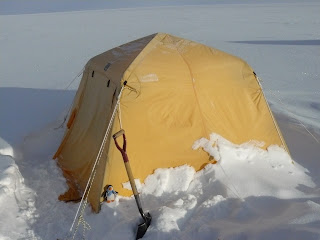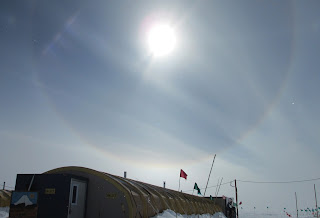I am back in McMurdo now, so I will post some notes I wrote when I was living at WAIS without internet:
I have been at the West Antarctic Ice Station (WAIS) for the last couple of weeks. Life in the deep field is very different from life in McMurdo. The camp is set up for the summer season only – the main purpose of the camp is to support the drilling operations. However, since the camp is there several programs share its resource to support their activities as well. There are a number of AWS stations on the West Antarctic ice sheet and we’re staying at WAIS camp while servicing them.
I have been at the West Antarctic Ice Station (WAIS) for the last couple of weeks. Life in the deep field is very different from life in McMurdo. The camp is set up for the summer season only – the main purpose of the camp is to support the drilling operations. However, since the camp is there several programs share its resource to support their activities as well. There are a number of AWS stations on the West Antarctic ice sheet and we’re staying at WAIS camp while servicing them.
There about 40 people at the camp right now, the population
is rather dynamic and people are coming and going – passing through and
rotating jobs. As in McMurdo the population is divided into “camp staff” and
“scientists”, but since it’s fewer people we actually get to interact with
everyone, which is really nice.
The camp consists of a few “Jamesway” tents – long
structure for multiple people to use. The biggest Jamesway is the Galley ,
there is another large one for washing/laundry and recreation. There’s a
communications tent, tent for temp visitors, tent for medical, tent for pilots
and several science “office” tents. Jamesway tents have stoves inside them, so
they are comfortable to stay in for the day.
The four semi continuous vertical lines parallel to the Jamesway row are cargo lines - this is where we stored some of our equipment, and all of the camp stuff is stored there as well.
In the upper left corner you can see a couple buildings that are isolated from the camp - this is drilling offices. The main drilling arch is buried under 50m of snow. I went to tour the arch and their operations, so I will try to post about them separately.
At about a hundred yards away there is a tent city (dots in the upper right corner)- sleeping quarters for the WAIS camp.
***
First thing first - I had to find a place to sleep. I came to WAIS with a "sleeping kit", which included a tent, a couple of tents, a sleeping bag, small camping pillow and last but not least - a pee bottle. The camp had a spare tent, so I did not need to put up my own (mountain tent), and had a luxury of living in an "Arctic oven":
It is really warm and bright inside. The coldest it got inside my tent was -14C and the warmest temperature was +11C. Having a shield from the wind really makes a difference! My last week at WAIS a big storm came through - high winds, low visibility and cold temperatures prevented us from going outside unless we absolutely had to. Yet, it was really warm and cozy inside the tent (although quite loud).
Second most important thing in a camp - food ;) Here's a closer look at the largest communal Jamesway tent - the Galley. This is were we ate, socialized, and relaxed.
In the upper left corner you can see a couple buildings that are isolated from the camp - this is drilling offices. The main drilling arch is buried under 50m of snow. I went to tour the arch and their operations, so I will try to post about them separately.
At about a hundred yards away there is a tent city (dots in the upper right corner)- sleeping quarters for the WAIS camp.
***
First thing first - I had to find a place to sleep. I came to WAIS with a "sleeping kit", which included a tent, a couple of tents, a sleeping bag, small camping pillow and last but not least - a pee bottle. The camp had a spare tent, so I did not need to put up my own (mountain tent), and had a luxury of living in an "Arctic oven":
It is really warm and bright inside. The coldest it got inside my tent was -14C and the warmest temperature was +11C. Having a shield from the wind really makes a difference! My last week at WAIS a big storm came through - high winds, low visibility and cold temperatures prevented us from going outside unless we absolutely had to. Yet, it was really warm and cozy inside the tent (although quite loud).
Second most important thing in a camp - food ;) Here's a closer look at the largest communal Jamesway tent - the Galley. This is were we ate, socialized, and relaxed.
Here's the entrance to the Galley closer - as indicated by the WAIS sign - the Galley is the most important building of the camp.
Here's how the Galley looks like inside. Note that there's no light bulbs - just windows in the roof of the James way tent. There is power in the Galley as well - so you can bring your laptop and work. The galley is also the place where we held camp meetings and science talks.
to be continued...




















































